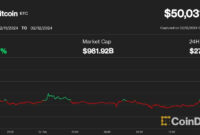What Is Bitcoin Mining? How Can You Do It? – CryptoKiNews
What Is Bitcoin Mining?
Bitcoin mining is solving mathematical equations — just really fast. That is why you need massive computational power to not only solve these mathematical queries quickly, but also quicker than everyone else in order to reap the rewards.
Chances are you hear the phrase “bitcoin mining” and your mind begins to wander to the Western fantasy of pickaxes, dirt, and striking it rich. As it turns out, that analogy isn’t too far off.Bitcoin mining is performed by high-powered computers that solve complex computational math problems; these problems are so complex that they cannot be solved by hand and are complicated enough to tax even incredibly powerful computers.
- Mining is the method of generating Bitcoin using computing power.
- Miners can use a variety of combinations when it comes to mining strategies to maximise their benefits.
- Cost of hardware and electricity tariffs have the biggest impact on profitability.
How does mining work?
During mining, computers solve complex mathematical equations. The first coder to crack each code is able to authorise the transaction. In return for the service, the miner earns small amounts of cryptocurrency. Once the miner successfully solves the mathematical problem and verifies the transaction, they add the data to the public ledger, called the blockchain.
What is a Bitcoin mining ‘rig’?
A ‘rig’ isn’t as scary as it sounds. It can be any everyday computer, made up of a CPU, motherboard, RAM and storage. The only difference is the graphics processing unit (GPU) or the ‘video card’.
When a computer isn’t mining, the GPU is what powers games, videos and other applications. Its computational prowess is ideal for Bitcoin mining’s heavy-duty requirements. In fact, a run-of-the-mill laptop with a high-performance GPU is likely to do a better job of mining for Bitcoin than an expensive laptop with an average GPU.
Proof of work
This is the algorithm that secures several cryptocurrencies, including Bitcoin, Ethereum, and Dogecoin. It ensures that no single authority becomes so powerful that it begins to run the show. This process executed by miners is a necessary part of adding new blocks of transaction data to the blockchain. A new block is only added to the blockchain system if a miner comes up with a new winning proof-of-work. This happens after every 10 minutes in the network. The goal of proof-of-work is to prevent users from printing extra coins they didn’t earn, or double-spending.
Why is it expensive to mine tokens?
In the early days, soon after Bitcoin came into existence in 2009, it was a profitable activity. At the time, miners would get 50 BTC (then worth $6,000) for solving each equation. Since the resources required to mine a single bitcoin were also less, miners were able to pocket most of the reward as pure profit. Although the reward for Bitcoin mining has decreased over time, the value of each BTC has increased hugely. As of April 2021, the value of a Bitcoin reward is nearly $3,33,000 (roughly Rs. 2.47 crores).
But the cost of Bitcoin mining has increased dramatically. This is because the competition for tokens is much higher, and high-performance computing is now required to successfully mine the tokens. As a result, the cost of the energy consumed in this process could be huge depending on the miner’s location and the type of hardware they use.
KEY TAKEAWAYS
- Bitcoin mining is the process of creating new bitcoin by solving a computational puzzle.
- Bitcoin mining is necessary to maintain the ledger of transactions upon which Bitcoin is based.
- Miners have become very sophisticated over the past several years using complex machinery to speed up mining operations.
A miner’s biggest cost is electricity
Electricity will be the largest expense over the life-cycle of a mining machine. When you run one or many machines continuously, possibly drawing hundreds of Watts each, this adds up very quickly.
Being located in a place with higher priced electricity, or needing power backup can drain most gains one makes. This is one of the reasons that the largest Bitcoin miners operated from China, when electricity was priced lower than most developed countries.
Pooling many machines together to increase compute power improves the chance of success. Running a single machine no matter how powerful, has a low chance of yielding Bitcoin. Moving up to a Bitcoin farm involves mining on a number of machines, with all of them logging in as the same user.
Cloud mining is a niche option. In this case, a user simply rents processing power directly instead of buying the hardware and paying for electricity.
Special Considerations
Rewarding bitcoin miners
With as many as 300,000 purchases and sales occurring in a single day, verifying each of those transactions can be a great deal of work for miners.2 As compensation for their efforts, miners are awarded bitcoin whenever they add a new block of transactions to the blockchain.
The amount of new bitcoin released with each mined block is called the block reward. The block reward is halved every 210,000 blocks (or roughly every four years). In 2009, it was 50. In 2013, it was 25, in 2018 it was 12.5, and in May of 2020, it was halved to 6.25.
Bitcoin successfully halved its mining reward—from 12.5 to 6.25—for the third time on May 11, 2020.
This system will continue until around 2140.3 At that point, miners will be rewarded with fees for processing transactions that network users will pay. These fees ensure that miners still have the incentive to mine and keep the network going. The idea is that competition for these fees will cause them to remain low after halvings are finished.
These halvings reduce the rate at which new coins are created and, thus, lower the available supply. This can cause some implications for investors because other assets with low supply—like gold—can have high demand and push prices higher. At this rate of halving, the total number of bitcoin in circulation will reach a limit of 21 million, making the currency entirely finite and potentially more valuable over time.
How can you start mining?
First, get a high-performance computer. Then create a wallet for Bitcoin and other popular cryptocurrencies. Once that is done, join a mining pool to maximise profitability. These pools are groups of miners who combine their resources to increase their mining power. The profit generated from mining is then distributed evenly to all members in the pool. Mining pools allow individuals to work together and compete more effectively.
Is Bitcoin mining profitable?
As with anything else, Bitcoin mining isn’t always profitable and goes through cycles.
Just like during the Californian Gold Rush, Bitcoin mining has many instances of businesses that sell hardware and services to miners being more profitable than the miners. Bitcoin is still in focus though, so mining makes a lot of economic sense.
For first-timers, online calculators take hardware and electricity costs as input, to calculate probable profits and clarify if mining is profitable for you.
Also CheckOut: Top 10 Cryptocurrencies in the world in 2021


